This post may contain affiliate links. Please read our disclosure policy.
These soft, homemade gluten free dinner rolls are easy enough for a weeknight—and special enough for any holiday table. They bake up golden, tender, and fluffy every time.
Why you’ll love these gluten free rolls:
- Soft, fluffy texture with a golden brown crust
- Quick 20-minute hands-on time with fast rise
- Dough is easy to handle—no stickiness or frustration
- Freezer-friendly for make-ahead convenience
- Simple to make dairy-free with easy swaps
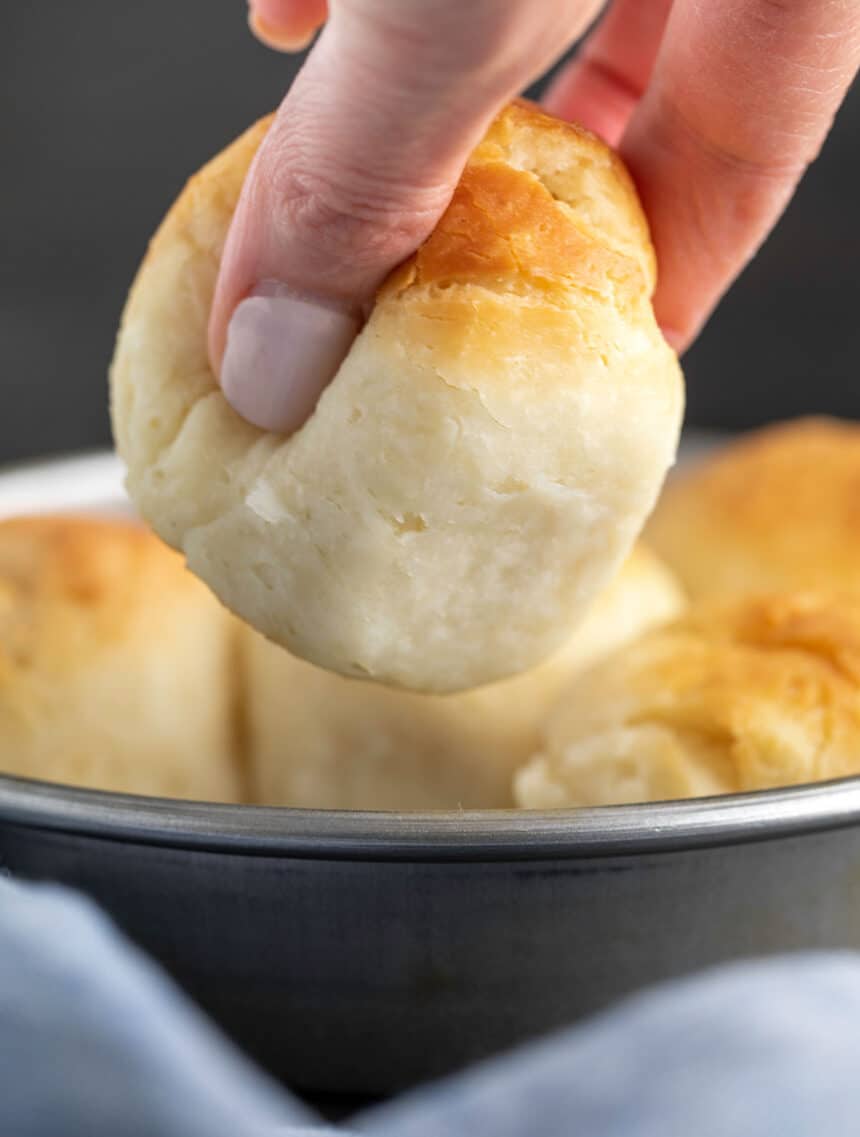
Recipe ingredients
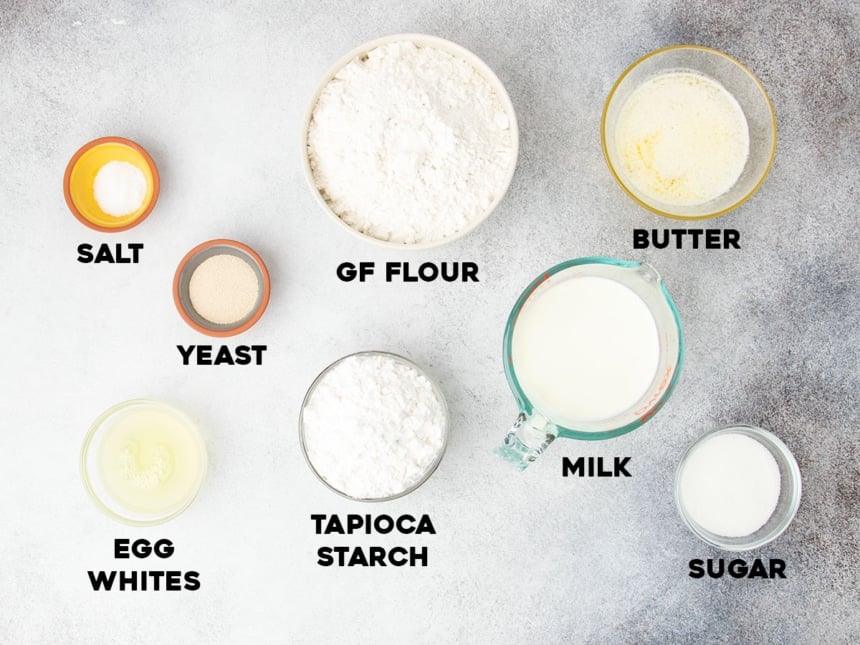
These few ingredients come together to make the softest, most tender gluten free rolls you’ve ever had:
- Gluten free flour – Use a high-quality all purpose gluten free flour blend made with finely ground rice flour. It should be designed for yeast baking.
- Tapioca starch – Even if your blend already includes some, this extra tapioca starch gives the dough stretch and flexibility.
- Instant yeast – Gives the rolls their rise. Also called rapid-rise or breadmaker yeast. Be sure yours is fresh.
- Sugar – Feeds the yeast and adds a subtle sweetness.
- Milk – Warm milk activates the yeast, moistens the dough, and adds richness.
- Butter – Adds moisture and flavor, keeping the rolls soft and tender.
- Egg whites – Provide structure and help bind the dough together.
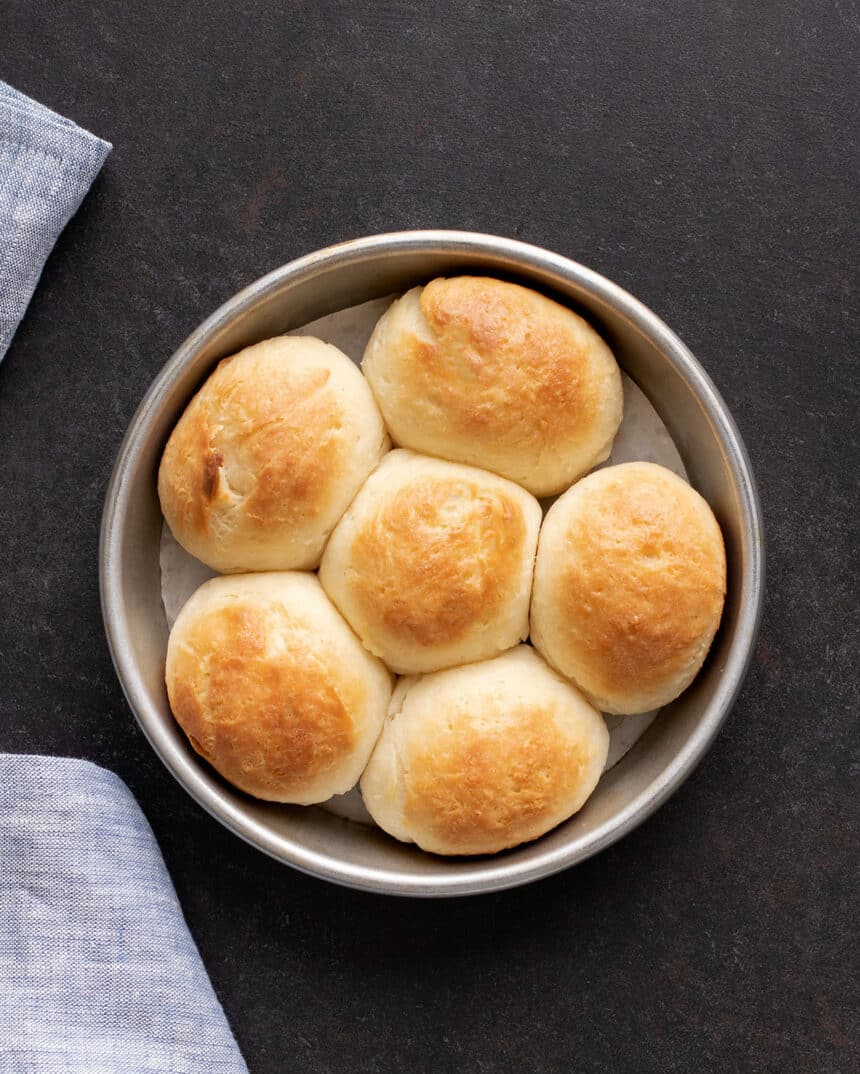
How to make soft gluten free dinner rolls
Step 1: Mix the dry ingredients
In the bowl of a stand mixer, if possible, whisk together the gluten free flour, xanthan gum (if needed), tapioca starch, yeast, and sugar until well combined. Whisk in salt next.
Step 2: Add wet ingredients and beat the dough
Pour in the warm milk, melted butter, and egg whites. Using the paddle attachment, beat the mixture until it comes together and begins to look whipped—about 6 minutes total.
Step 3: First rise
Transfer the dough to a lightly oiled container with a tight-fitting lid. Let it rest at room temperature for about 2 hours, or refrigerate it for up to 24 hours. If chilled, let the dough come back to room temperature before shaping.
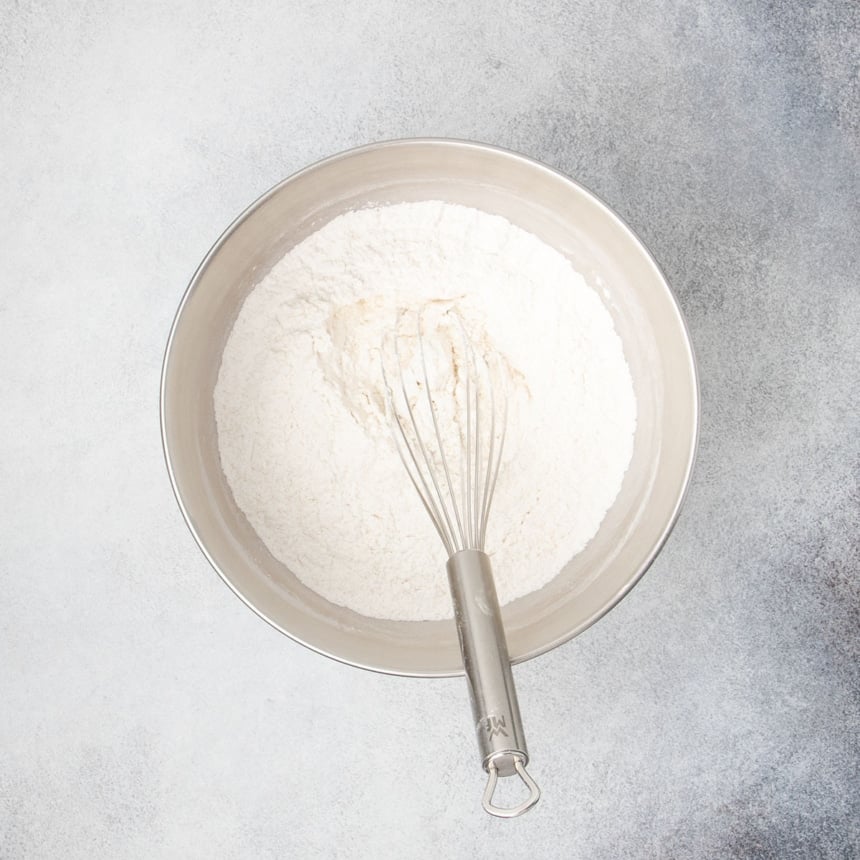
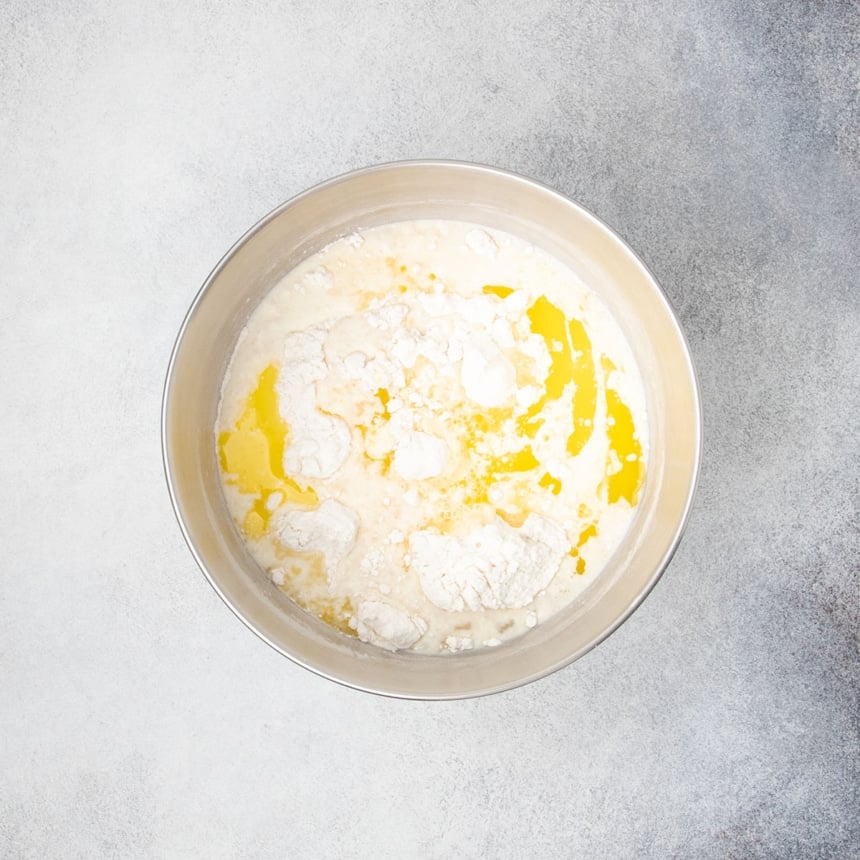
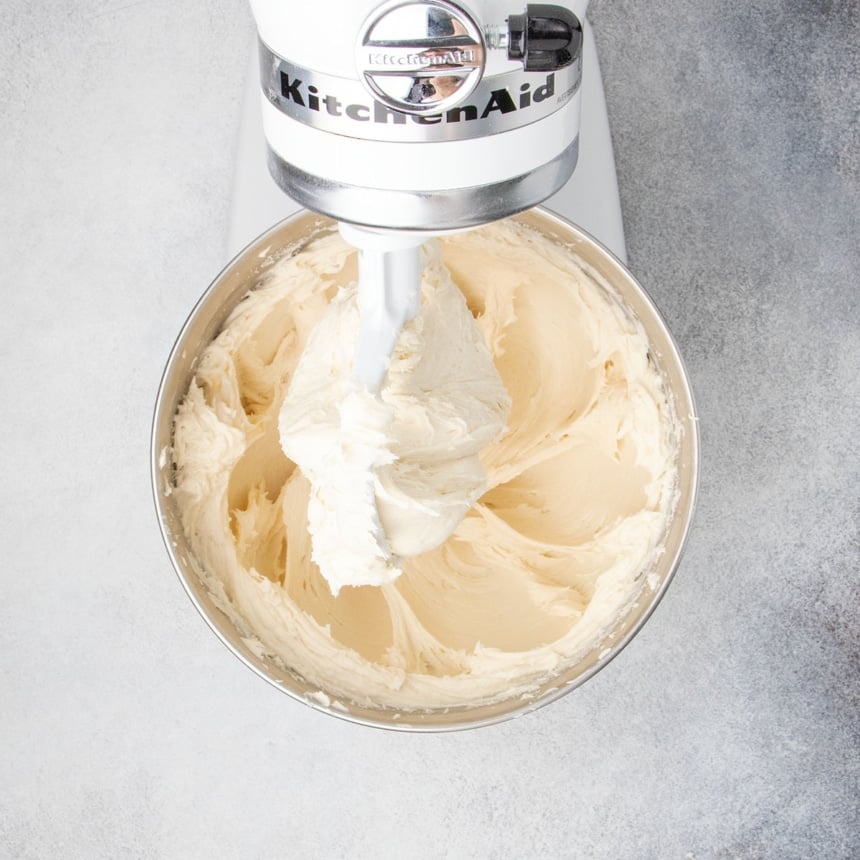
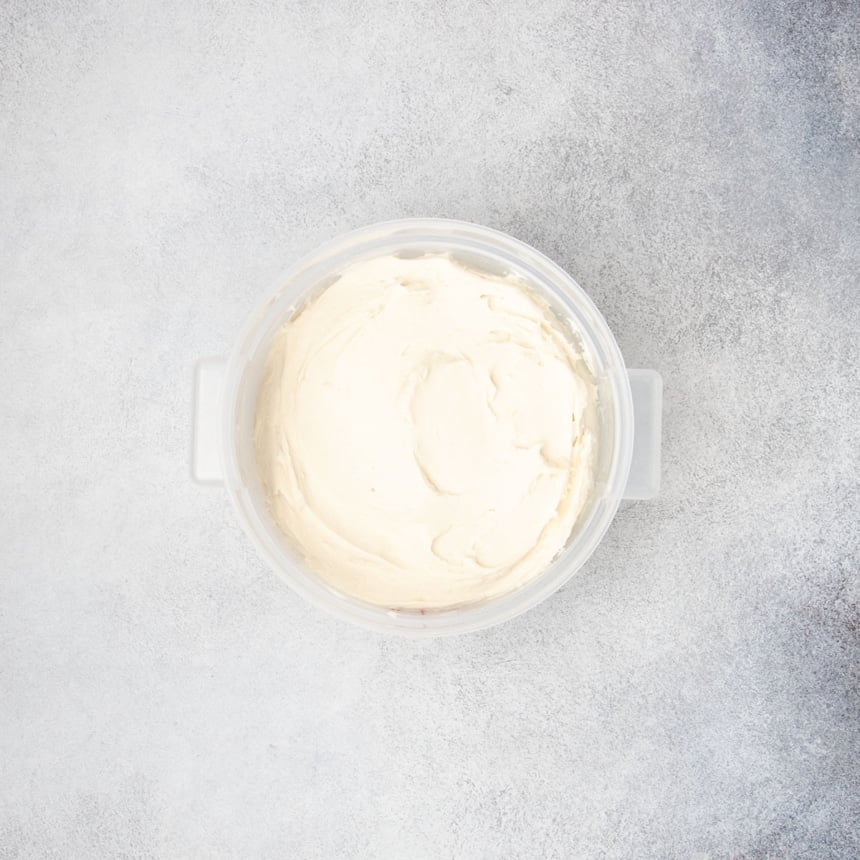
Step 4: Divide and shape
Turn the dough onto a very lightly floured surface and divide it in half, then each half into 8 equal pieces. Gently roll each piece into a ball by cupping your hand around the dough and moving it in a circular motion.
Step 5: Arrange and rise again
Place the rolls into a greased and lined baking pan. You can crowd them slightly for pull-apart rolls or leave space for individual ones. Cover with plastic wrap and let them rise in a warm, draft-free spot until at least 150% of their original size (they won't double).
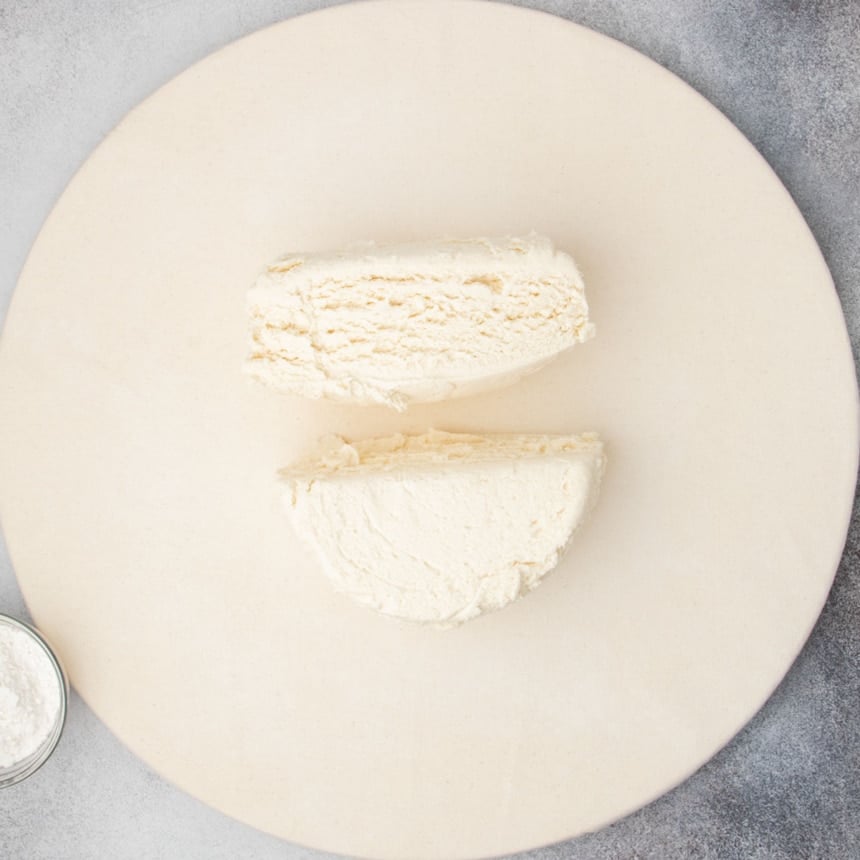

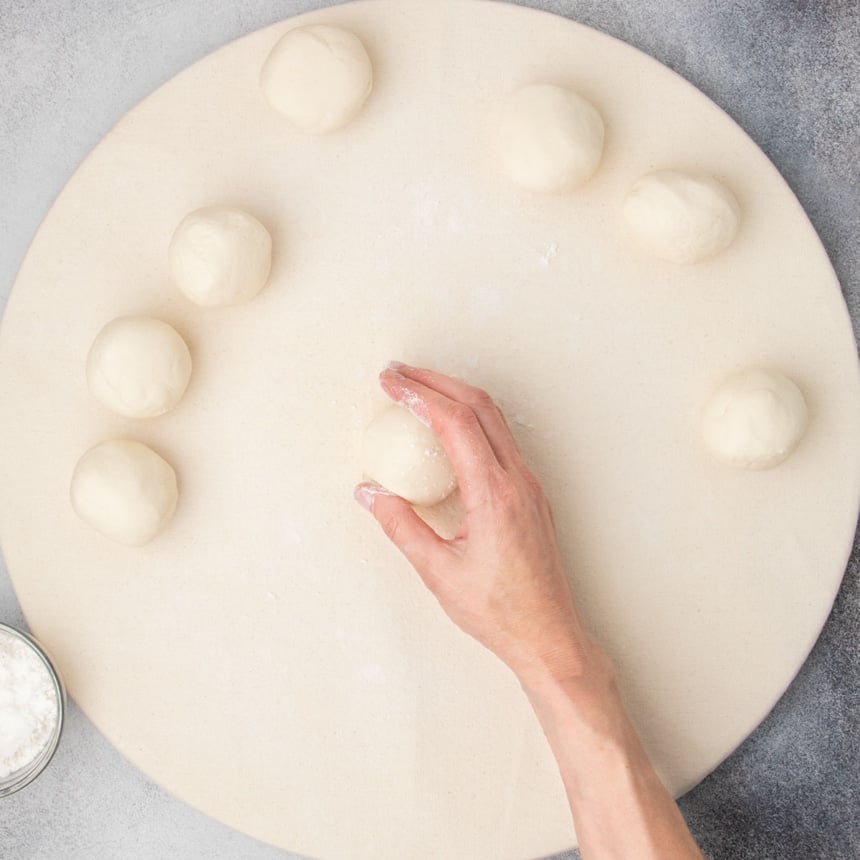
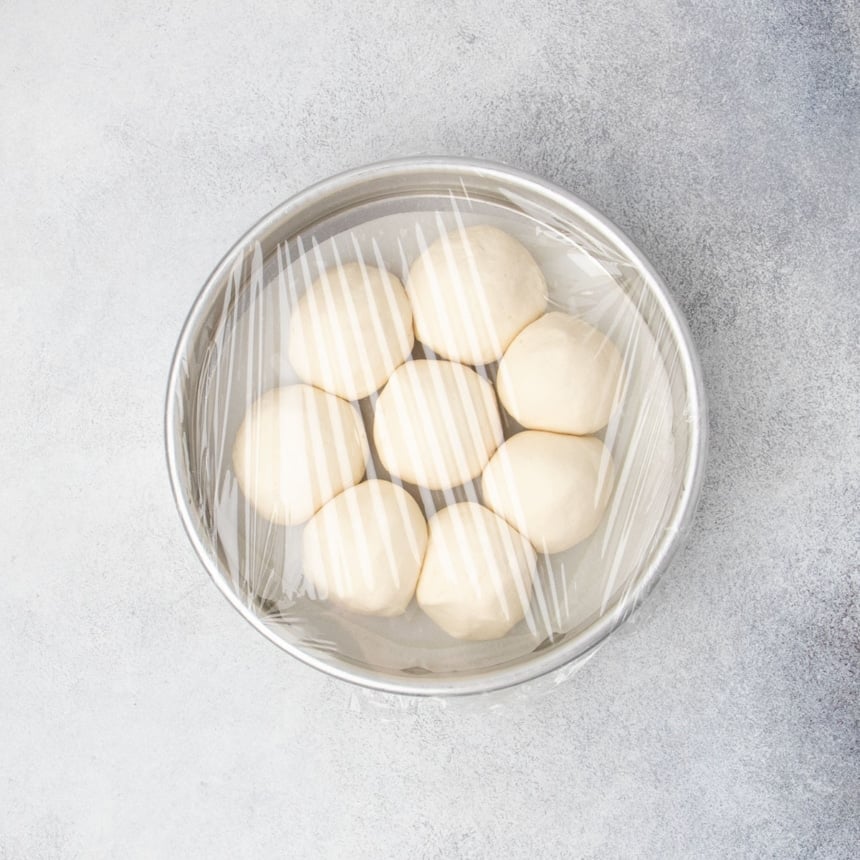
Step 6: Bake
Once risen, brush the tops with melted butter. Bake at 375°F until the rolls are golden and an instant-read thermometer reads around 190°F in the center—about 20 minutes. If the rolls are touching, reduce the oven temp to 350°F after 18 minutes and bake a bit longer.
Step 7: Serve warm
Brush the hot rolls with more melted butter, and serve while warm and soft.
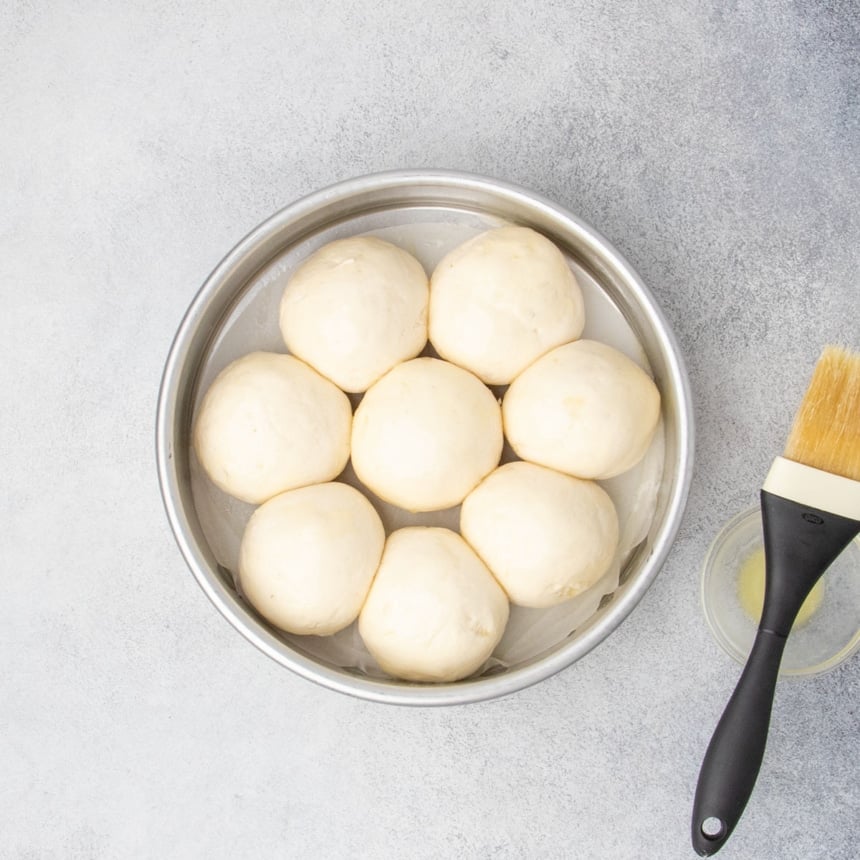
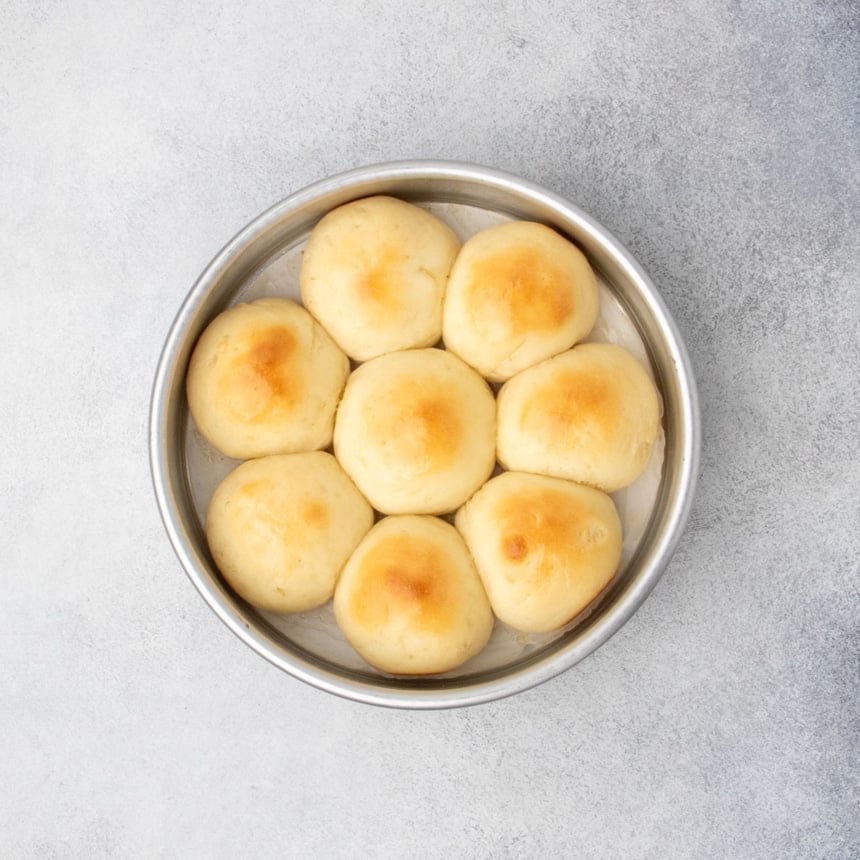
Expert tips for perfect rolls
Use a stand mixer if you can
A stand mixer with the paddle attachment creates the smooth, whipped dough that gives these rolls their signature texture. If needed, a food processor with a plastic blade can work—just pulse carefully and don’t overmix. Avoid hand mixing.
Create a warm, steady rise
Place your dough in a draft-free spot with gentle warmth—like on top of a warm oven, never inside. If the environment is too hot, you risk killing the yeast. Too cool, and the dough will rise very, very slowly. Too dry, and it won't rise.
Adjust for dry climates
If you live in a dry environment and your dough isn’t rising well, try adding 1 extra tablespoon of warm milk or water. But don’t overdo it—too much liquid can cause overproofing and gummy rolls.
Shape gently
Don’t press or knead the dough aggressively. On a lightly floured surface, cup your hand around the dough ball and gently move it in a tight circle on a very lightly floured surface to create a smooth round shape.
Want to make them ahead? Try parbaking
To prep rolls in advance, bake the shaped rolls at 300°F for about 15 minutes—just until puffed and set but not browned. Cool completely, then freeze. When ready to serve, defrost at room temp, then finish baking at 375°F until golden and fully cooked (190°F inside). This method gives you fresh-baked rolls in less time.
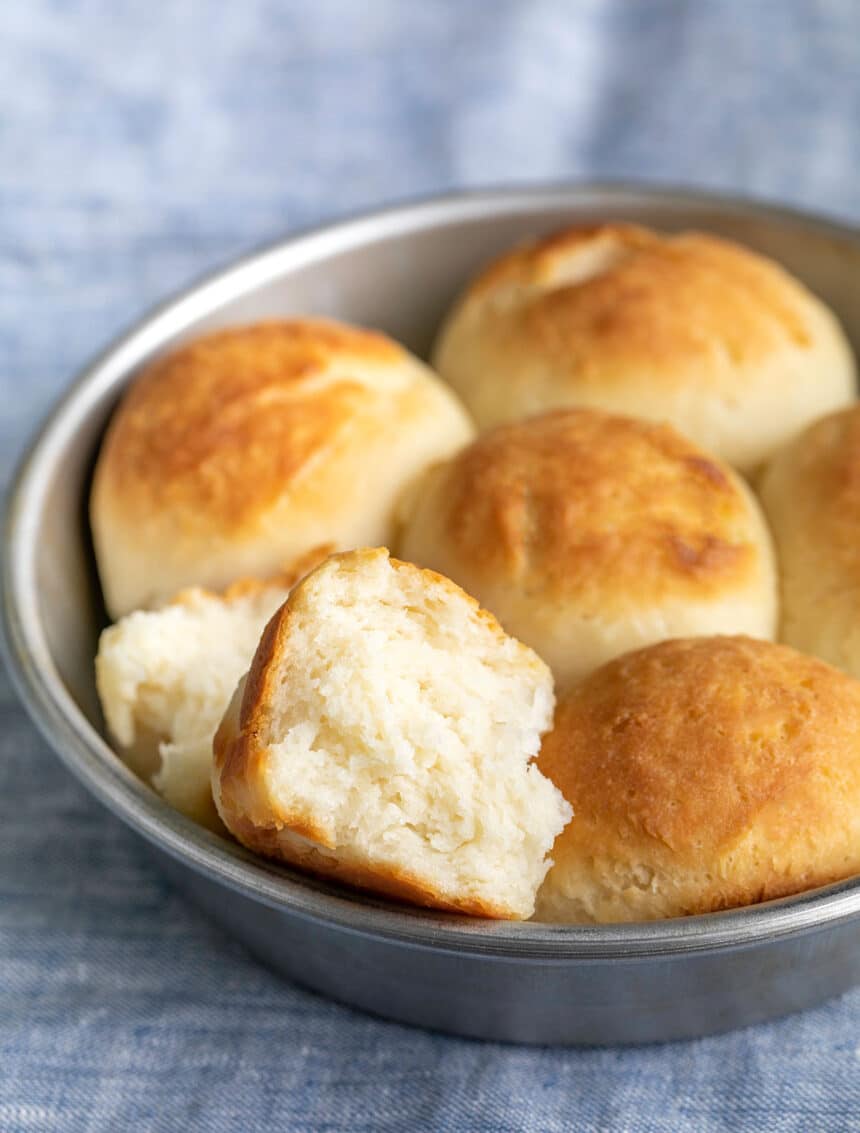
Easy ingredient swaps
Dairy free
Replace the melted butter with a block-style dairy-free butter alternative. Melt and Miyoko’s Kitchen brands both work well. For the milk, use an unsweetened nondairy variety with some fat and a texture that mimics cow's milk Avoid fat-free options, since richness matters here, and anything with unwanted texture, like oat milk.
Egg free
You should be able to replace the 2 egg whites with 50 grams of aquafaba (the liquid from a can of unsalted chickpeas).
Yeast
You can’t make these rolls without yeast, but you can swap instant yeast for active dry yeast. Use 15 grams of active dry yeast and be sure to proof it first in some of the warm milk.
Tapioca starch
Even though most good gluten free flour blends already include tapioca starch, this recipe needs extra. If you don’t have it, try replacing it with an equal amount of superfine glutinous rice flour or sweet white rice flour.
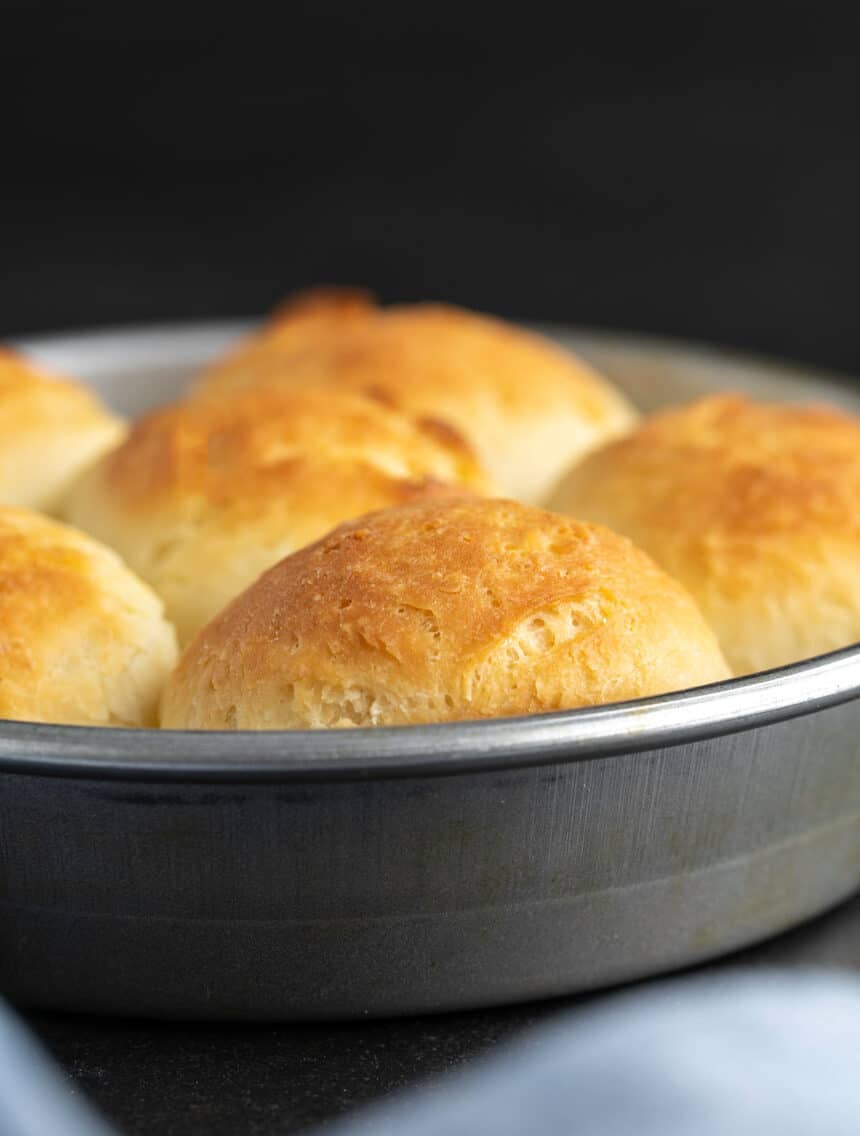
Gluten Free Dinner Rolls Recipe
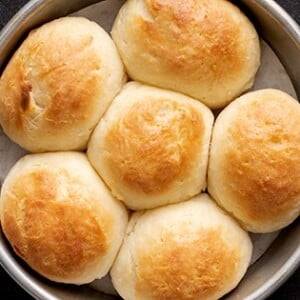
Ingredients
- 3 ¼ cups (455 g) all purpose gluten free flour blend, (See Recipe Notes)
- 3 ¼ teaspoons xanthan gum, omit if your blend already contains it
- ⅞ cup (105 g) tapioca starch/flour, plus more for sprinkling
- 4 teaspoons (12 g) instant yeast, See Recipe Notes
- ¼ cup (50 g) granulated sugar
- 1 teaspoon kosher salt
- 1 ⅝ cup (13 fluid ounces) warm milk (about 90°F)
- 8 tablespoons (112 g) unsalted butter, melted and cooled (plus more for brushing)
- 2 (50 g) egg whites, at room temperature
Instructions
Make the dough
- In the bowl of a stand mixer (See Recipe Notes), place the flour, xanthan gum, tapioca starch/flour, instant yeast, and granulated sugar, and whisk to combine well. Add the salt, and whisk again to combine.
- Add the milk, melted butter, and egg whites. Using the paddle attachment, beat vigorously. The mixture will come together in a clump and clear the sides of the bowl. Keep beating until it begins to look whipped, and sticks to the side of the mixing bowl again (about 6 minutes total).
- Transfer the mixture to a lightly oiled bucket or bowl with a very tight-fitting lid. The container should be large enough for the dough to nearly double (although it won’t double fully).
Chill the dough
- Refrigerate the dough for at least 30 minutes and up to 3 days in the refrigerator. Do not let the dough rest/rise for too long, or your rolls will rise much more irregularly after shaping.
- If your dough has been refrigerated for more than 1 hour, allow it to sit at room temperature until no longer very cold to the touch before working with it.
Shape the rolls
- Grease a quarter sheet pan or 2 8-inch round cake pans for baking, and set them aside. You will later decide if you’d like to crowd the rolls, and have them rise then bake touching, or have them separate.
- Flour a clean, dry work surface very lightly with tapioca starch. Divide the dough in half, then each half into 8 equal portions, for 16 pieces, each about 2 1/2 ounces in weight.
- Working with one piece of dough at a time, cup your fingers around the dough, keep the side of your palm on the surface, and move your hand in tight circles to coax the dough into a round.
- Place the shaped rounds of dough in your chosen baking pan(s) either touching (they will rise mostly up), or a bit more than 1-inch apart, taking care not to crowd them (the will rise up and out).
Let rise
- Cover the pan(s) with lightly greased plastic wrap, place in a warm, draft-free location, and allow to rise until about 150% of their original size (they won't quite double).
- This rise can take anywhere from 45 minutes to hours, depending upon the ambient temperature in your kitchen. Overproofing is not very likely, and can be detected when the surface of the rolls begins to look pockmarked.
- When the rolls are nearing the end of their rise, preheat your oven to 375°F. Once the rolls are properly risen, remove the plastic wrap from the pan(s), and brush generously on all exposed sides with melted butter.
Bake
- Bake until an instant read thermometer inserted into the center of each roll reads about 190°F.
- If there is any space between the rolls after they’ve risen, they will take around 20 minutes until fully baked.
- If the rolls are touching one another, lower the oven temperature to about 350°F at 18 minutes and continue to bake for about another 5 minutes or until the center reaches 190°F.
- Remove the pan from the oven, and with the rolls still in the hot pan, brush again with melted butter and serve warm.
Video
Notes
I recommend Better Batter’s original blend or my Nicole’s Best multipurpose blend (with 3 teaspoons added xanthan gum). King Arthur's gluten free bread flour can work but makes denser rolls, so consider adding 2 tablespoons more milk. Avoid Cup4Cup and Measure for Measure here—they won't produce the right texture. Bob’s Red Mill 1-to-1 isn't ideal, but in a pinch, it can work if you add 1½ teaspoons extra xanthan gum. To make your own blend using one of my “mock” recipes, please see the all purpose gluten free flour blends page. Using active dry yeast:
You can swap instant yeast for active dry yeast—just use 15 grams instead of 12 and proof it in some of the warm milk before adding. No stand mixer?
A food processor with the plastic blade works in a pinch. Don’t use a hand mixer or mix by hand; the dough needs vigorous mixing to whip up properly and create a smooth shaped roll.
Nutrition
Nutrition information is automatically calculated, so should only be used as an approximation.
Storing & freezing the rolls
Best when fresh
Like all yeast rolls, these are at their best the day they’re baked. But you can still store and reheat them with great results.
Room temperature
Store leftover rolls in a sealed container at room temperature for up to 2 days. To refresh before serving, sprinkle lightly with lukewarm water and warm in a 300°F toaster oven for about 5 minutes.
Freezer storage
Once cooled, place baked and cooled rolls in a freezer-safe zip-top bag and press out as much air as possible. Freeze for up to 3 months. Defrost at room temperature and reheat as above. For parbaking instructions, see the Expert Tips section above.
FAQs
If your rolls didn’t rise, it’s usually a problem with the yeast, hydration, temperature, or timing. Here are the most common causes:
Expired yeast – Test it by mixing with warm water and sugar. If it doesn’t foam in 10 minutes, it’s no longer active. Store opened jars of yeast in the refrigerator.
Too much flour/too little moisture – Overmeasuring flour or starch can reduce hydration and stall rising. The same can happen if the dough rises improperly covered, and loses moisture.
Temperature issues – Milk that’s too hot can kill yeast.
Timing – You simply didn't let them rise long enough. Yeast will reproduce in cooler environments, but will just take longer. Overproofing happens when dough rises too much, not for too long.
No—you still need the additional tapioca starch listed in the recipe. All gluten free blends include some tapioca, but this recipe relies on a larger amount to give the dough its flexibility and the rolls their soft, stretchy texture.
No—this dough won’t hold its shape that long after shaping. It’s best to refrigerate the dough before shaping, then bring it to room temperature and shape right before the second rise.
Not recommended—it's best to bake and freeze the rolls, or use the parbake method above.
Yes, but they won’t have the same pull-apart quality. Bake time may be slightly shorter.
Yes—just cut all ingredients in half. I do this all the time! Rise and bake times stay the same.
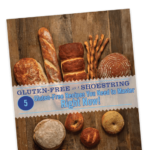
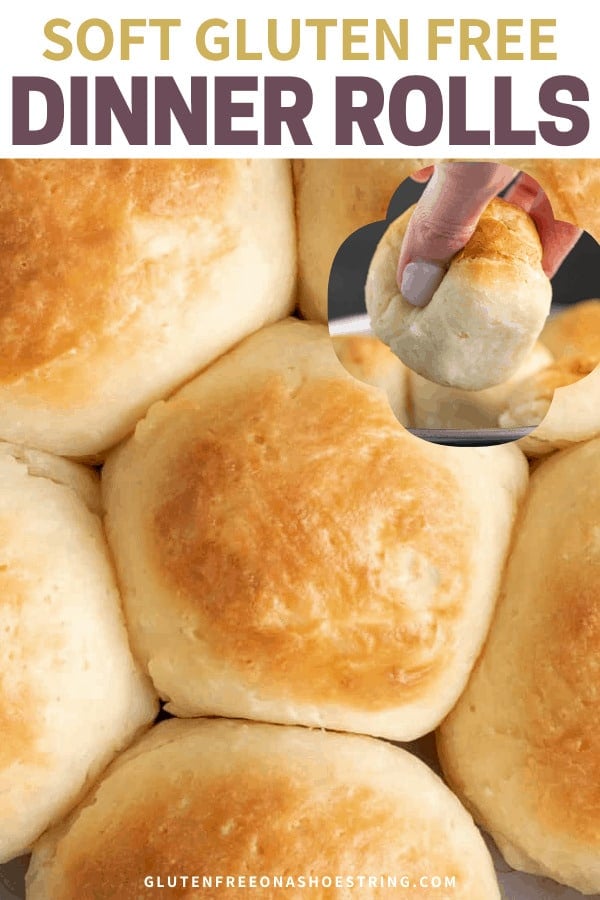
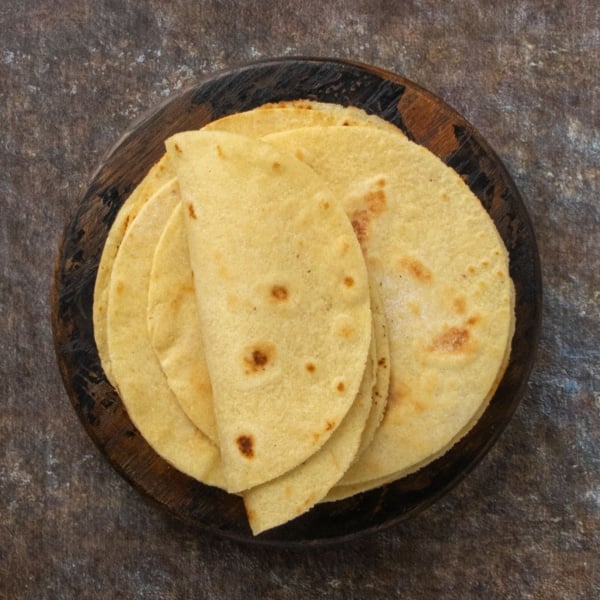
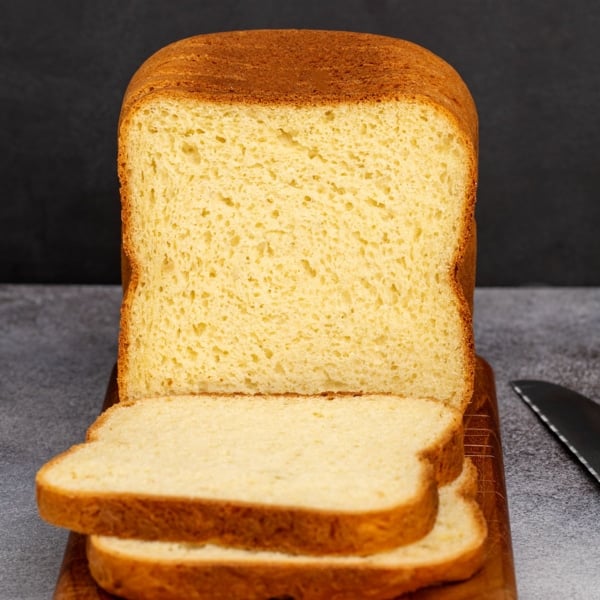
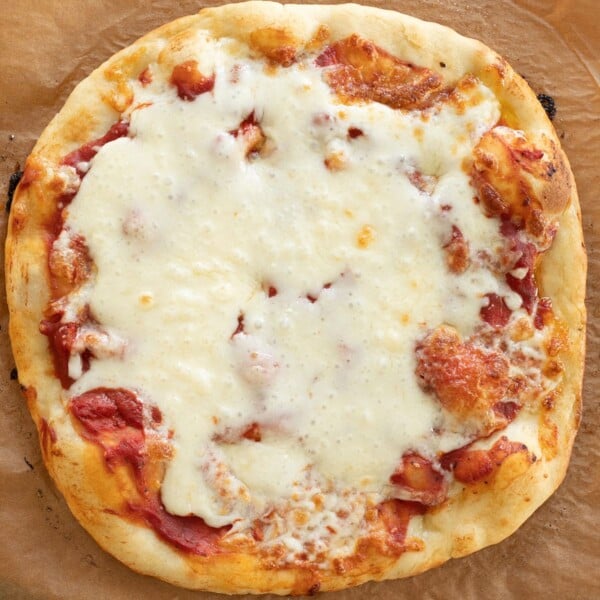
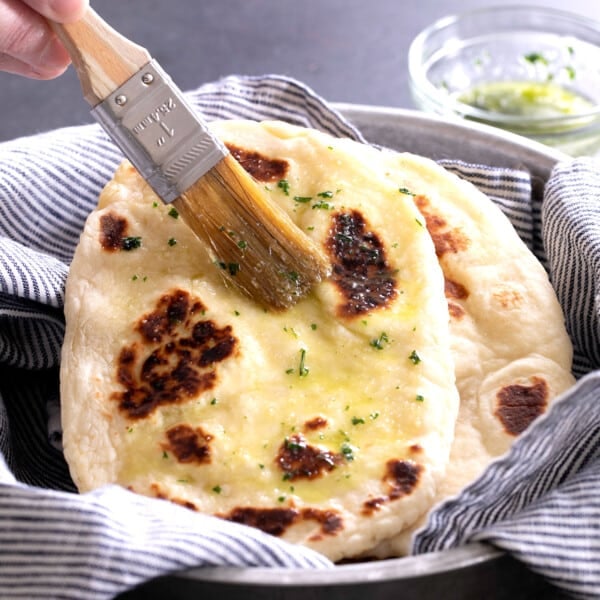









These rolls are wonderful! The first time I made them they came out a little dense because I didn’t give them enough room to rise and the brand of yeast I had was a brand I don’t usually use. Even then they were still delicious. So I tried them again and let them rise in a larger container with better yeast and they came out PERFECT. I used Better Batter flour blend and didn’t make any substitutions. Such an easy and beginner friendly recipe and a spectacular result!
I’m really glad to hear that, Grace. Thank you so much for sharing your experience, and I’m really glad you were able to diagnose your original issue. I think that’s why I think of yeast bread as a bit of art along with the science. Well done!
I have made this recipe 3 times now and have used coconut oil rather than butter to make it dairy free. The gf flour I use is Pamela’s Bread Flour. The rolls have turned out amazing every time my husband was shocked when I told him they were gf and dairy free. I found the dough had the best texture for shaping when I make it the night before and refrigerated it. Then I pull it out about 2-3 hours before I am ready to work with it. I added saffron and rolled them into Lucia Buns today. I love this recipe and what a gift to let my son eat his favorite food again, bread. Thank you.
I’m glad to know that your coconut oil swap for butter worked well, Merissa. Glad you’re enjoying the bread recipe!
I am obsessed with your gluten-free Japanese milk bread and literally have made it a million and one times since my discovery. I had been searching for a gluten-free yeasted bread that mimicked the same scrumptious ones I knew in childhood, and the milk seemed to be the IT factor as far as producing a soft, buttery texture. How are these in comparison? And/or could I use the Japanese milk bread dough to make dinner rolls with as well? Should I shape by hand or is it best to bake them in muffin tins, as I know many gluten-free doughs lose their shape unlike traditional doughs. Thank you in advance! Looking for some holiday yeasted dinner rolls for the holidays this year!!
These don’t lose their shape at all, Vanessa, which you can see from the photos. I’m really glad you enjoy the Japanese milk bread recipe. I would recommend this recipe for dinner rolls, as you might imagine!
Is that 2 egg whites that are 50 grams each (totaling 100 grams), or 50 grams of egg whites total, and it’s about 2 egg whites?
In all recipes, the number in parentheses is the weight measurement alternative to the volume measurement, Pat. So it’s a total of 50 grams.
That’s what I thought, based on how the other ingredients were setup, but I just wanted to make sure, since the recipe isn’t turning out correctly for me, so I wanted to make sure that I had that part right, as I’m trying to see what I might’ve done wrong. Thanks!
Here are my usual suggestions for you to investigate, Pay: Everyone says that they “followed the recipe to a T” but it’s rarely the case, in ways you just don’t realize are important, but are. Here are some considerations and questions to ask yourself as you attempt to figure out where you deviated from the recipe as written:
Did you make ingredient substitutions, particularly the gf flour blend? They are not all created equal at all. Please see the AP GF flour blends page, which is linked in every recipe that calls for one.
Did you measure by weight, not volume? You can’t measure properly by volume, especially dry ingredients like flour, as human error is unavoidable.
With respect to yeast bread, did you allow the dough to rise long enough, and was your dough covered properly? Overproofing is a function of rising too much, not too long. It can take a long time for yeast bread to rise properly in a cool, dry environment, especially. You must also be sure that any refrigerator rise is done in a container that is well-sealed, or the bread will dry out and not rise due to lack of moisture. And watch the how-to video to see what texture you should expect from the dough right out of the bucket, and then as you shape it. It will not be as you expect from conventional gluten-containing bread dough.
Hi! I’m loving your recipes that I’ve tried so far! They’re all so delicious! I made these rolls, and the flavor is delicious, but they’re dense. I followed the recipe, and I even used your mock better batter flour with the super fine rice flours. The first rise seemed good, but once I shaped them, they didn’t seem to rise much, and I had them in a warm place for a long time. Do you have any ideas of what I might have done wrong, and what I could do better next time?
Here are the questions I recommend asking yourself when yeast bread doesn’t rise as expected, Allison: Did you measure by weight, not volume? You can’t measure properly by volume, especially dry ingredients like flour, as human error is unavoidable. With respect to yeast bread, did you allow the dough to rise long enough, and was your dough covered properly? Overproofing is a function of rising too much, not too long. It can take a long time for yeast bread to rise properly in a cool, dry environment, especially. You should also check your yeast to make sure it’s fresh, and make sure you’re using instant yeast, not active dry. It’s also called breadmaker or rapid-rise yeast.
Thanks for the reply! I did measure them by weight! :) and, I did the first rise for 2 hours, since you said it needs to be risen for at least 2 hours the first rise. I’m wondering if it was too hot for the second proof. I had my inside oven on 300 degrees, but instead of putting my pan on the center of the stovetop, I put it towards the back where the heat comes out. Since we have a gas stove, the actual stovetop doesn’t get super warm from the inside, except in the back. But, I’m wondering if it was maybe too hot? Unless, I did something wrong with the first rise, but I did it for 2 hours. My yeast was fresh. I’d just gotten it at the store, and I made sure the expiration date wasn’t passed! Do you have another idea of where I could do the second rise, since maybe the stovetop might not work with out gas oven?
I don’t ever recommend artificially heating the environment like that for yeast bread rising, Allison, as it’s easy to increase the temperature of the yeast so much that it dies, like it does in the oven. Yeast will be active at quite a range of lower temperatures, just more slowly. That’s why it rises in the refrigerator. You also need to ask yourself if your dough became dried out at any point in handling it. You should be using very little flour to shape it, or you lower the hydration ratio which inhibits and sometimes prevents rising.
I made the rolls again yesterday, and they were less dense. I live in a dry place, so maybe I’ll try doing the additional tablespoon of warm milk in my dough, like you mentioned in the recipe. I was wondering, what # of speed do you mix the dough on? Your recipe says to mix it vigorously, so I did a high speed, but I’m wondering if maybe I over beat it? My dough didn’t do the thing where it sticks to the sides of the bowl at the end of the 6 minutes like yours does. It kind of did a tiny bit the second time I made it, but not like in your video.
We loved these rolls! I am NOT a professional baker by any means, and this is the first gluten free bread I have ever attempted from scratch. My husband, who we just found out is celiac, said they were great and my dad (who is not celiac) said he would eat them over regular rolls any day! I weighed all of my ingredients, temperature-checked everything and essentially followed your recipe to a T. The only deviation was I added a little extra flour at mixing because my dough was really wet for some reason. I also definitely overcrowded my pan (lesson learned) so they took a little longer to cook and ended up a little dense. But they were crispy on the outside, soft and chewy on the inside and the flavor was delicious – a little on the yeasty side and 100% tasted like normal, homemade white bread. They are a labor of love but I will definitely make them again in the future!
The denseness could also have been a function of your having added more flour, Alexa, particularly before shaping, as that lowers the hydration ratio. As I mentioned to another commenter, you may have to adjust your expectations for how wet gluten free yeast bread dough is as compared to conventional bread dough. It has to be a bit sticky or it won’t have enough moisture for the dough to properly rise. You’ll get there!
I followed all the steps – no substitutions, and I measured everything with a scale. I used Better Batter flour (The one with xantham gum already in it). But after the first rise (2 hrs, dough almost doubled), the dough is so sticky it’s impossible to work with. I can’t think of anything I did wrong. Maybe I had the mixer on for too long or not long enough?
Raw gluten free yeast bread dough is always going to be somewhat sticky or it won’t have enough moisture to rise, Leah, so perhaps it’s just your expectation of how easy the dough will be to shape? I’m afraid I don’t know where you may have deviated from the recipe as written, but watching the how-to video might help?
Is there a how-to video linked on this recipe? I couldn’t find it anywhere – but that definitely might help! The dough was so wet I just had to scoop it out with a spatula or else it would just be all over my hands. I just plopped it onto some tapioca starch and was able to carefully prod it into a round shape. They weren’t bad, but I do feel like I went wrong with the texture somewhere. I followed the recipe 100%, except I used oat milk instead of regular milk.
Yes, Leah, there is a how-to video but you won’t see it, or any of the other videos, if you don’t turn off any ad blockers you might be using. I expect that my readers don’t use ad blockers, anyway, since ads are the only way I get paid for my hard work in developing these recipes, and sharing all the details about how to make them. In addition, if your oat milk is not the thin, smooth consistency of cow’s milk, I recommend against using it as a cow’s milk substitute. It won’t have enough moisture if it’s thick.
My dough was very sticky as well (too much to handle at all), BUT I poured a bit of olive oil in a plate and added a bit of oil to my hands before I rolled each piece and it worked perfect! Hopefully that helps <3
This bread is delicious! It has a slightly sweet smell and taste. I followed the recipe pretty close except for allowing the bread to stay in the fridge for 24hrs. I was too impatient. I took it out at 18hrs. I used the mock better batter recipe and the bread flour recipe using expandex. I also used guar gum instead of xanthan gum because I have a corn sensitivity. After I formed the dough into rolls, I let them proof in the round pan on top of the stove and turned the oven on so that the stove top would get warm. It worked perfectly! My rolls remind me of a cornbread texture but not crumbly, which I’m perfectly fine with. I’ve been on an elimination diet and haven’t had bread in months! Thank you for the recipe!
Cyn, this recipe is not developed to be made with my bread flour blend. There’s too much liquid in it, and the cornbread texture you’re describing is due to all the substitutions. I’m glad you’re happy with the results, though!
Thanks. With your recipe I finally could make, with some adjustments. low carb buns. I used almond flour and kokos flour, fiber husk, erythritol and a lot more milk and a bit of water. Your comment on how much fluid gluten-free dough needs to rise has helped me to feel the dough to make certain that the flour and fluids are in balance so that the dough rises correctly. I am a fan of your recipes. My daughter has to eat eat gluten-free. Every recipe I have tried from your books has worked out perfectly. I eat low carb because of my bloodsuckers. Your experience with gluten free baking has helped me a lot to bake almost everything.
Greetings from the Netherlands
Hi, Riemke, I’m really glad you’re pleased with your results. For others’ sake, that’s really an entirely different recipe with that many substitutions and I’m afraid I can’t promise results if you’re making my recipes with anything other than an all purpose gluten free flour blend as defined on my gf flour blends page.
I tried making this recipe twice, carefully weighing out all ingredients. The rolls were like rocks – very dense and unpalatable. I even tried letting the dough rise 3 times instead of just once. The only difference between the recipe and what I did was substitution of buttermilk for whole milk (didn’t have milk on hand). Don’t know what went wrong, but they were far from light.
Buttermilk has significantly less moisture than milk, Signe, which would easily account for the lack of rise. Without proper moisture, yeast bread will not rise. I’m removing the star rating as you didn’t follow the recipe, so it’s not a proper representation. I would also, as always, look at your flour blend, measuring by weight, all the of the things I stress in every yeast bread recipe.